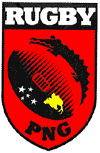Rugby union in Papua New Guinea
| Rugby union in Papua New Guinea | |
|---|---|
 | |
| Country | Papua New Guinea |
| Governing body | Papua New Guinea Rugby Football Union |
| National team(s) | Papua New Guinea |
| Registered players | 3,200 (total) [1] |
| Clubs | 80 |
Papua New Guinea is a tier three rugby union playing nation. They began playing international rugby union in 1966 and have yet to make the Rugby World Cup. Teams from Papua New Guinea have competed in the Commonwealth games.
Although Papua New Guinea has a rugby union tradition, rugby league is far more popular and is the national sport. Despite this, there are 8520 registered players of rugby union and 57 clubs.
The national side is ranked 55th in the world (as of 2 June 2014).
Governing body
The governing body is the Papua New Guinea Rugby Football Union.[2]
History
Rugby is long established in PNG, and tends to fall under the Australian sphere of influence. The game has been played as a folk sport in many regions, and the country's general lack of infrastructure has hindered its national development.
Due to its close relationship with Queensland in Australia, rugby league is very strong in the country.
Former Grand Slam Wallaby Brendan Moon lives on the island, and has been helping the development for a number of years.[3]
As with many of the Pacific Nations, PNG has tended to do best at rugby sevens, and has a strong national sevens team.[3]
National team
The Papua New Guinea national rugby union team is nicknamed the "Puk-Puks", from the Tok Pisin word for "crocodiles". They have not qualified for a Rugby World Cup yet.
See also
External links
References
- Cotton, Fran (Ed.) (1984) The Book of Rugby Disasters & Bizarre Records. Compiled by Chris Rhys. London. Century Publishing. ISBN 0-7126-0911-3
- ↑ "Archived copy". Archived from the original on 25 September 2011. Retrieved 25 September 2011.
- ↑ Archives du Rugby: Papouasie Nouvelle Guinée (French) retrieved 29 September 2009
- 1 2 Bath, Richard (ed.) The Complete Book of Rugby (Seven Oaks Ltd, 1997 ISBN 1-86200-013-1) p72